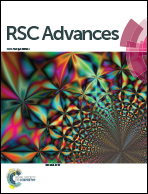Fluorescence enhancement of fisetin by silver nanoparticles with cetyltrimethyl ammonium bromide micelles†
Abstract
In this work, in situ synthesized cetyltrimethyl ammonium bromide micelles-capped silver nanoparticles were used to sensitively and directly detect fisetin. Fisetin molecules solubilize in the Stern layer of cetyltrimethyl ammonium bromide micelles and mainly bind to the head group of the micelles by electrostatic interaction and hydrophobic effect. Silver nanoparticles also solubilize in cetyltrimethyl ammonium bromide micelles and form the micelles-capped silver nanoparticles. The suitable distances between fisetin molecules and silver nanoparticles for the fluorescence enhancement are provided by the micelles. The synergistic action of the solubilization and sensitization of micelles and metal-enhanced fluorescence of silver nanoparticles promote the fluorescence enhancement of the system. Under optimized conditions, the fluorescence intensity of the system exhibits a linear response with the concentrations of fisetin in the range from 5.0 × 10−8 mol L−1 to 7.0 × 10−6 mol L−1 and the detection limit (S/N = 3) is 1.5 × 10−9 mol L−1. Compared to the other methods, the developed method has higher sensitivity. Moreover, the method has been successfully used to detect fisetin in actual samples.


 Please wait while we load your content...
Please wait while we load your content...